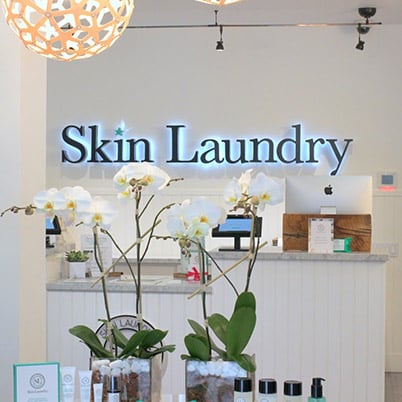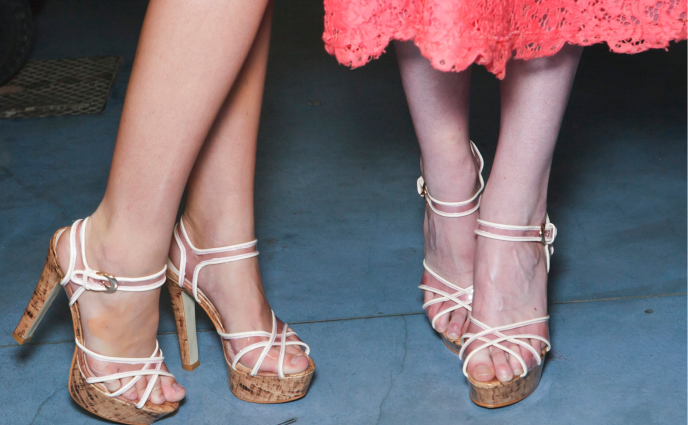At its purest, least complicated state, "laser" is defined by light amplification by Stimulated Emission of Radiation. Since you probably didn't go to med school like board-certified dermatologist Dr. Papri Sarkar, here's what that means: a very narrow and intense beam of monochromatic light excites your atoms and molecules. In practice, this means laying in your doc's office as they use a device over scarring or fine lines and wrinkles on your face, using light to alleviate the symptom. If you've thought about laser hair removal, the process is the same, except the laser will target your hair follicles.
Image via Getty
Image via Getty
You probably didn't realize energy-based technology could do more than light your home or power your car but actually improve your skin, too. Dermatologist Dr. Quenby Erickson says lasers are used to treat several concerns on our body and face, which is why they're so commonly used and recommended. From reversing the signs of aging, regenerating our skin to look smoother and other benefits, various lasers fulfill different needs. There are many types of lasers (more on that later), but Erickson says they fall into two categories: non-ablative, which gently and effectively improves minor issues with little downtime, and ablative lasers, which do the opposite. The more intense regimen is meant for serious ailments and does require rest for up to a week.
Image via Getty
Image via Getty
There's no age minimum to begin a laser treatment, but dermatologist and co-founder of the Precision Skin Institute Lesley Clark-Loeser, MD, recommends talking to a trusted professional before starting the process. Because lasers can morph and transform our pores, the choice shouldn't be taken lightly. "An individual may consider lasers for improvement in a particular skin condition. Our current armamentarium of lasers allows us to treat an extremely broad spectrum of both medical and aesthetic skin conditions," she says. What do they include? Everything from acne, rosacea and skin cancer to unwanted hair growth, scarring, uneven pigmentation, wrinkle reduction and much more, Clark-Loeser says.
When you speak with your dermatologist, they'll decide which type of laser to use for your specific skin woes. This is why you don't have to be a certain age to begin since many uses for lasers are as appropriate when you're 25 as when you're 65. "It really depends on the problem that is being treated. For scars, poor texture and uneven skin tone, patients can be treated in the teenage years. For fine lines and wrinkles, you can start in your 20s, 30s or 40s," says dermatologist Dr. Kristina Goldenberg.
Image via Imaxtree
When you speak with your dermatologist, they'll decide which type of laser to use for your specific skin woes. This is why you don't have to be a certain age to begin since many uses for lasers are as appropriate when you're 25 as when you're 65. "It really depends on the problem that is being treated. For scars, poor texture and uneven skin tone, patients can be treated in the teenage years. For fine lines and wrinkles, you can start in your 20s, 30s or 40s," says dermatologist Dr. Kristina Goldenberg.
Image via Imaxtree
There's no one-laser-fits-all solution for everyone, but if you don't have anything specific you're stressed about, Erickson suggests talking to your derm about a prejuvention treatment like a BBL, or Broad Band Light, in your late 20s to early 30s. "Starting these treatments early on will ensure less wrinkles and aging later in life if maintained properly," she explains. If you're already up to 40 candles on your birthday cake and only now considering this procedure? Don't sweat it since Erickson says lasers are also fantastic for correcting skin conditions that were caused by previous sun damage and aging and are very effective for people in their 40s and on.
Image via Imaxtree
Image via Imaxtree
The optimal time for a laser treatment is in the fall or winter when our skin hasn't been exposed to an abundance of vitamin D from the sun. As Erickson explains, the laser isn't as effective with a tan as it is when your skin is its natural tone. Also, if the laser you choose requires a recovery time, being away from potentially harmful UV rays when your skin is sensitive post-treatment will ensure your health. Before you have your first treatment, Erickson recommends using a retinol to prepare your pores, revving up the rejuvenation of your cells. Her go-to product is Alastin Regenerating Skin Nectar with TriHex Technology. "This product clears the extracellular matrix of any unwanted or damaged skin cells while making more room for the new skin cells to grow and develop," she says. You should use this at least two weeks prior for optimal results.









